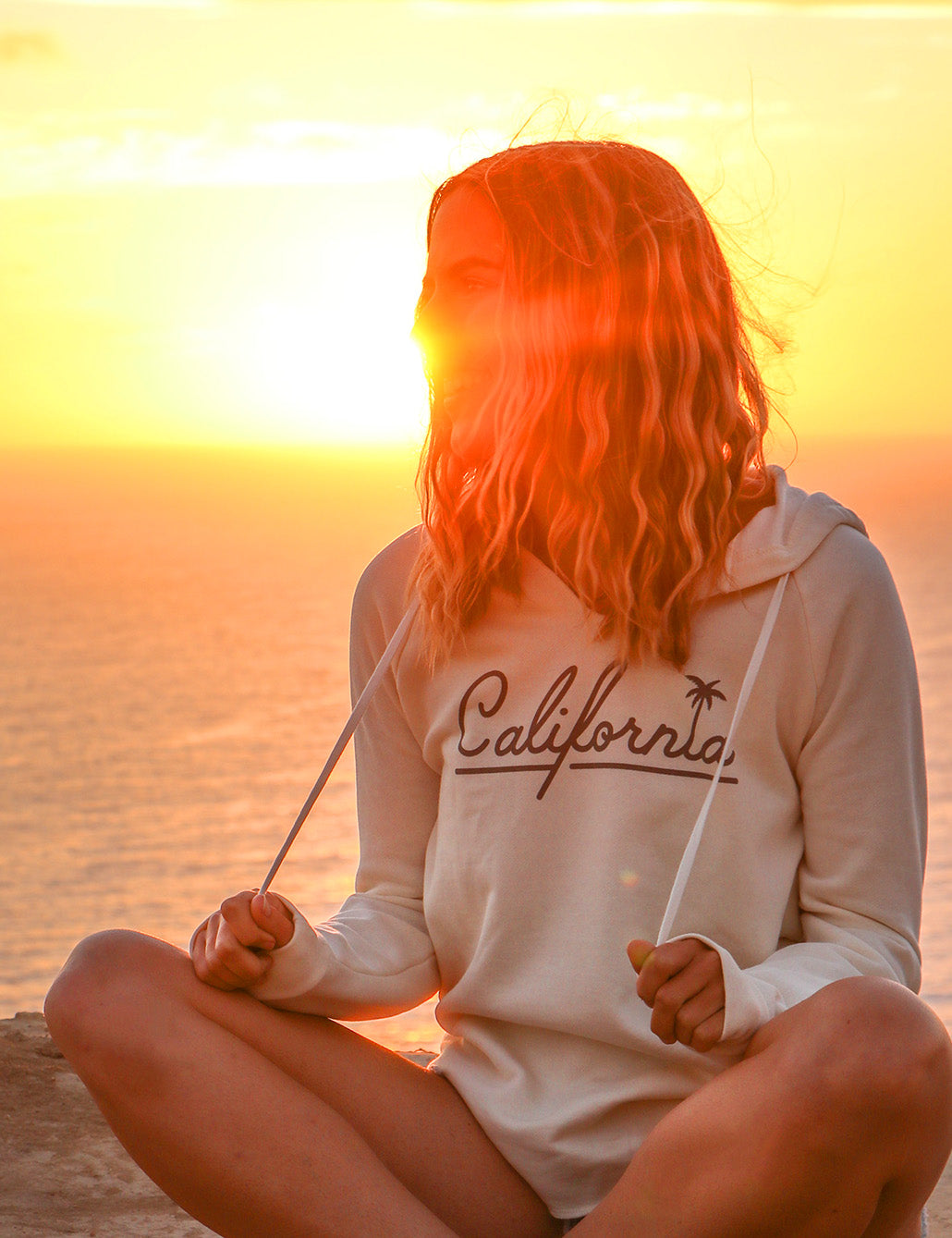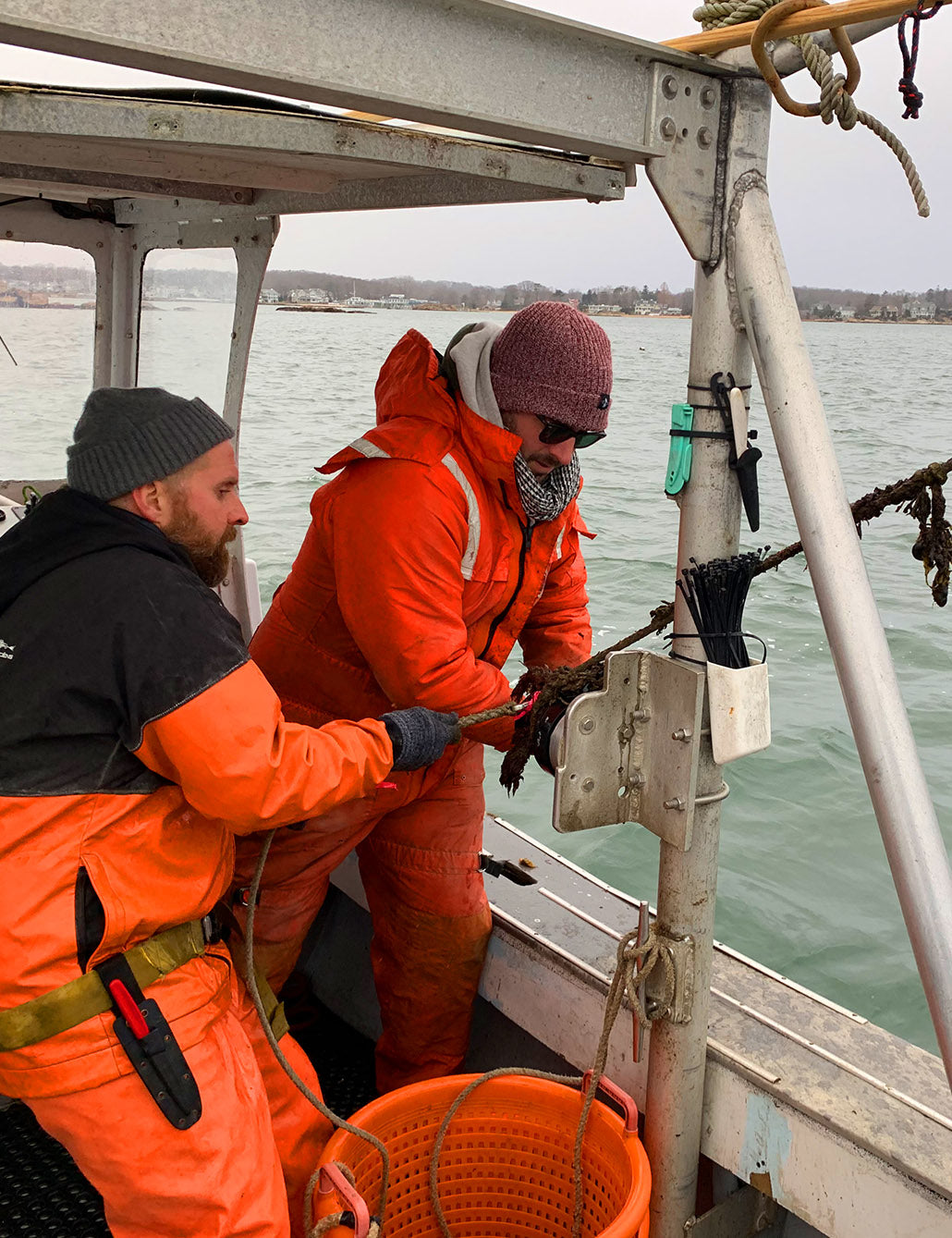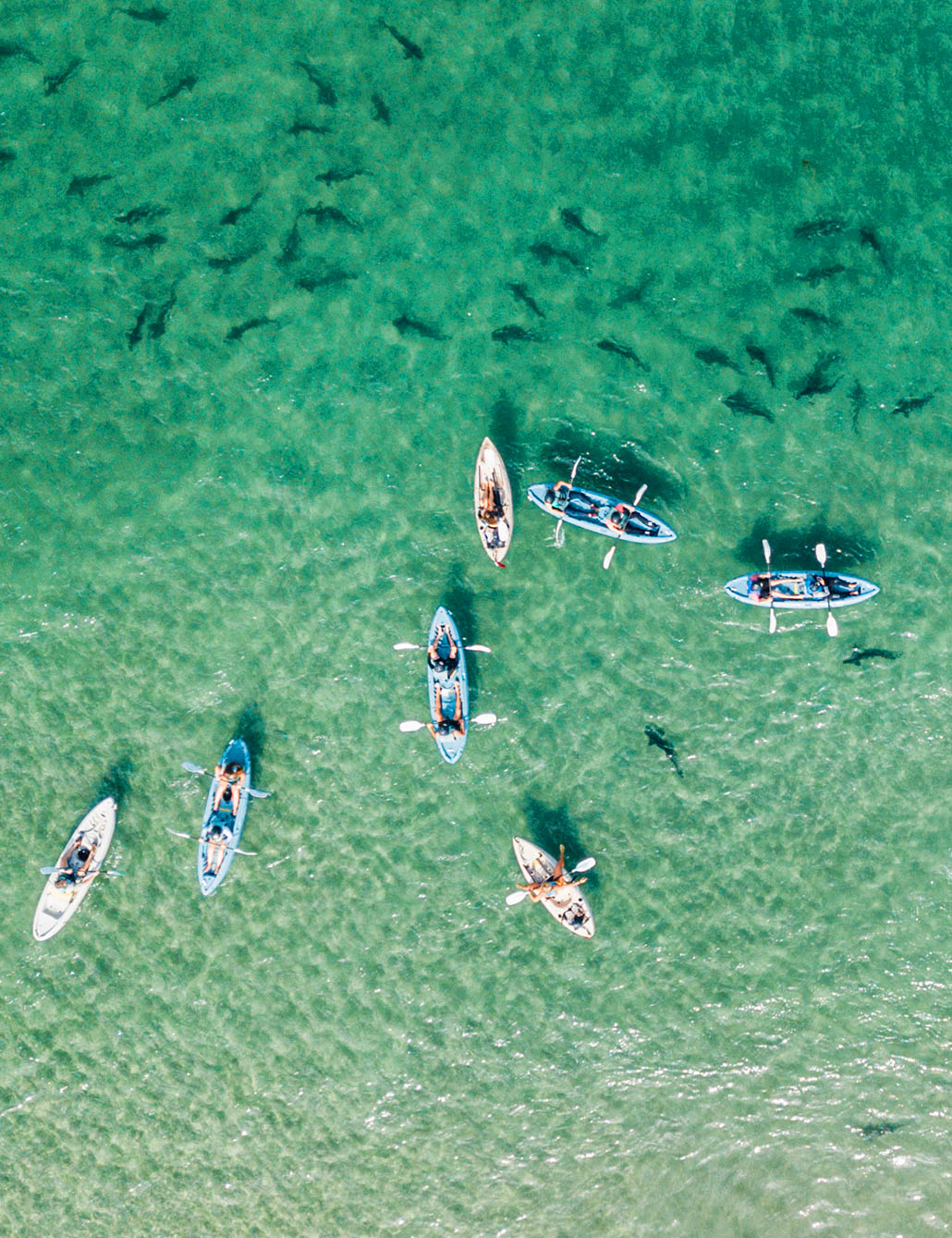By Danielle Joy | CEO of Cetaceans and Manager of Mysticeti
This blog post comes from Danielle Joy of Aloha Tours San Diego. Danielle is an experienced tour guide and an expert in the local area and the marine life within it. Today she is sharing information on gray whales, one of the animals that she encounters on her expiditions in San Diego.
Check her out on Facebook and Instagram for videos of her adventures with the diverse marine life in the La Jolla Ecological Reserve!

Gray Whale Facts
Appearance
These large whales can grow to about 49 feet long and weigh approximately 90,000 pounds. Females are slightly larger than males. Gray whales have a mottled gray body with small eyes located just above the corners of the mouth. Their pectoral flippers are broad, paddle-shaped, and pointed at the tips. Lacking a dorsal fin, they instead have a dorsal hump about two-thirds of the way back on the body, and a series of 6 to 12 small bumps, called “knuckles,” between the dorsal hump and the tail flukes. The tail flukes are nearly 10 feet wide with S-shaped trailing edges and a deep median notch. They have barnacles and whale lice (i.e., cyamids) on their bodies, with higher concentrations found on the head and tail.
Barnacles and whale lice are a fact of life for gray whales; there are hundreds of pounds of barnacles on gray whales. These barnacles attach themselves to gray whales in the lagoons when the whales are born. Barnacles stay on gray whales for as long as they are alive. Barnacles depigment the skin when they attach themselves to the whale. When the barnacles die and fall off, they leave a small round white circle or ring. Barnacle scars create a unique pattern on each whale, which can help in identifying the gray whale. Gray whale lice are not true parasites. They feed on the skin and damaged tissue which is beneficial to whales. Whale lice gather around open wounds or scars of the whale. Lice can spread from mother whales to their calves during birth, and nursing.
Mother (cow) & baby (calf)
-The typical gestation period for a female gray whale (the period from conception to birth) lasts around 12 months.
-Gray whales (male & female) reach sexual maturity around 8 years old.
-Healthy females (cows) can calve every other year (but every 3rd year is more common).
-Calves remain with their mother until mid-August.
“The 15 15 50”
-The average length of a gray whale calf at birth is 15 feet, can weigh up to 1,500 pounds and they can drink up to 50 gallons of milk a day, produced by their mothers mammary glands.
-The milk that is produced by the mother is high in nutrients in order to give the calf all of the nutrition it needs to develop into a healthy young whale.
-This nursing/feeding period for the baby whale lasts for about 6–8 months or until lactation stops. Whale milk is extraordinarily rich, with about 53% fat (human milk is about 2% fat).
-Calves can gain 60 to 70 pounds every day on their mother’s milk.
-The baby whales are often born in shallow waters which are believed to help prevent their young from being attacked by their two top predators; sharks and killer whales.
-Within about three hours of birth, a calf can keep itself afloat and swim on a steady course. A calf may rest on its mothers back or fins until it becomes a stronger swimmer.
-Mothers are very protective of their calves; they earned the name “Devilfish” because of their violence towards whalers who killed their babies.

Behavior and Diet
Gray whales are frequently observed traveling alone or in small, mostly unstable groups, although large aggregations may be seen in feeding and breeding grounds. Like other baleen whales, long-term bonds between individuals are thought to be rare.
They are primarily bottom feeders that consume a wide range of benthic (sea floor) and epibenthic (above the sea floor) invertebrates, such as amphipods. They can eat one ton a day of shrimp-like amphipods. Gray whales are like cattle on an open range, they travel wherever they can find food.
Since gray whales have no teeth, they capture and strain their baleen, which hangs from the roof of the mouth. Grays are the only bottom feeding whales. When they feed, a whale dives to the bottom, rolls on its side and gulps mouthfuls of mud from the bottom. As the whale closes its mouth, water and sediments squirt out through the baleen plates. In doing so, they often leave long trails of mud behind them and "feeding pits" on the seafloor. This leaves the amphipods stuck to the baleen inside their mouths. Whales then use their tongues to loosen the amphipods from the baleen, and swallow.
Gray whales usually favor one side of their body while feeding & scraping the bottom. When the whale surfaces, you can see that one side of their body usually has more barnacles. If there are more barnacles on the left side the whale is right brained (handed) and vice versa.

Where They Live
Gray whales are found mainly in shallow coastal waters in the North Pacific Ocean, although during migration, they do sometimes cross deep waters far from shore. There are two geographic distributions of gray whales in the North Pacific:
-
The eastern North Pacific stock or DPS, found along the west coast of North America
-
The western North Pacific stock or DPS, primarily found along the coast of eastern Asia
Most of the eastern North Pacific stock gray whales spend the summer feeding in the northern Bering and Chukchi seas, but some feed along the Pacific coast during the summer in waters off of Southeast Alaska, British Columbia, Washington, Oregon, and northern California. In the fall, eastern North Pacific gray whales migrate from their summer feeding grounds, heading south along the coast of North America to spend the winter in their wintering and calving areas off the coast of Baja California, Mexico. Calves are born during migration or in the shallow lagoons and bays of Mexico from early January to mid-February.
From mid-February to May, eastern North Pacific gray whales can be seen migrating northward along the U.S. West Coast. Although western and eastern stocks of gray whales were thought to be relatively isolated from each other, recent satellite tagging data and photo-identification and genetic matches have shown that at least some western North Pacific gray whales migrate across the northern Gulf of Alaska, and along the west coast of British Columbia, the United States, and Mexico.
-There are an average of 23,000 individual gray whales along the west coast.
-San Diego has 78 miles along the gray migration path making La Jolla the perfect spot for whale watching.

What to look for
Spouts- These are usually the first thing you see while whale watching. On a clear day (no or little wind) their spout can reach 20 feet high. Baleen whales have 2 blowholes, so at a certain angle their spout is in the shape of a heart. If you’re close enough, you can smell their breath.
Birds- There could be a few different reasons to see large groups of birds over the ocean. There might be a bait ball (swarm of fish) that the birds are hunting, or they might be trying to feed off of whales. Sometimes birds dive down and pick the lice off the barnacles when they surface in the water.
Footprints- A whale’s footprint is a consequence of the whale’s forward motion propelled by its tail flukes. This trail or slick puddle known as a whale’s footprint, marks the spots where the whales had surfaced for their breaths.
Breaching – This refers to when 80-90% of its body jumps out of the water. They do this sometimes to communicate with each other, attract other whales, or warn off other males. Landing on the water creates a large sound underneath the water. If they see a school of fish they try to land on the school, stunning them and making them easier to consume. Some scientists say they’re just having fun when they breach.
*Humpbacks are the most acrobatic whale & seem to breach more frequently than gray whales.
Fluking/fluke diving – Fluking is when a whale lifts its tail (fluke) out of the water at the beginning of a dive. When the whale is going deep & you most likely won’t see them for a while. Feeding dives may range from 3 minutes up to 15 minutes; they can stay underwater for 30 minutes.
Spyhopping- When the whale spyhops, it vertically pokes its head out of the water.

Common Questions
What are baleen plates?
Baleen whales have a series of 130-190 fringed, overlapping baleen plates hanging like curtains from each side of the upper jaw. Baleen is made of a fingernail-like material called keratin. The plates are off-white and about 2-10 inches long. Baleen plates filter water out and trap food in. The baleen is replaced about every 5 years.
Do gray whales sleep?
Some scientists say the whales do not stop swimming during migration, but think they may sleep and continue swimming on “autopilot.” Others say the whales take short naps of 10-20 minutes
What does the gray whales skin feel like?
The skin has scratch marks and patches of white barnacles, and orange whale lice. A whale’s skin feels like a peeled hard-boiled egg. Most of the adult grays have scars and tooth-rake marks from encounters with Orcas. Light gray or white scars show where the whale barnacles have fallen off. Young whales have barnacle patches soon after they are born.
How big are gray whales?
Adult males can reach a length of 45 feet. Adult females are slightly larger, and reach about 50 feet in length. Both sexes weigh up to 30-40 tons. The gray whale’s flukes or tail can span up to 10 feet.
Do gray whales sing?
Gray whales make gurgles and warbling sounds, but nobody really understands what these sounds mean.
Do gray whales sleep?
This is what some scientists say, the whales do not stop swimming during migration, but think they may sleep and continue swimming on “autopilot.” Others say the whales take short naps of 10-20 minutes.
How can I recognize a gray whale?
Gray whales have streamlined bodies with narrow, tapered heads with the upper jaw slightly overlapping the lower jaw. The gray whale has no dorsal (top) fin, but, about 2/3 of the way back on the body is a prominent dorsal hump; this is followed by 6-12 knuckles along the dorsal ridge that extend to the fluke (tail). Its fluke is about 10 feet across, pointed at the tips, and deeply notched in the center; there are also 2-5 grooves on the ventral throat.
How big are gray whales eyes?
An adult’s eyes are just above their mouth outline and are about the size of baseball, they are located about 8 feet from the tip of the gray whale’s head. They also have eyelids. I have also talked to some scientists who say you can tell the age of a gray whale by the protein in their eyes (during a necropsy to determine the cause of death).
How long can a gray whale stay underwater without coming up for air?
An adult gray whale can stay submerged for up to 20-30 minutes.
Do gray whales have teeth?
No, the gray whale is in the suborder Mysticeti; the Mysticeti whales have a baleen instead of teeth.
Are gray whales friendly?
Visitors to the calving and breeding lagoons sometimes encounter the “friendliest,” gray whales that come up to the small boats and let people touch them.
How long does a gray whale live?
Grays whales live about 40 to 60 years, some can live 70 years.
At what age do gray whale’s mate and breed?
Gray whales reach sexual maturity somewhere between 5 and 11 years of age. A gray whale that lives to be 40 years old could have as many as 18 calves.
How long is a gray whale’s pregnancy?
Gestation is 11-12 months; migration and reproduction are connected, since it is best for the mothers to reach warm waters before giving birth. Gray whales have a special adaptation called delayed implantation; the embryo does not start developing in the mother’s body until a few months after she becomes pregnant. After mating in the lagoons (or during migration), the newly pregnant female returns to the arctic feeding waters on spring’s journey north. She feasts for herself and her unborn baby and migrates south in fall or winter to the nursery lagoons to give birth. By the time she reaches the warm lagoons, the baby has been developing for 11-12 months and is ready for birth. A female usually has one calf every two years.
What do newborn calves look like?
Newborns are dark gray to black, some may have distinctive white markings, and a calf weighs between 1,100-1,500 pounds. Babies weigh between 1,500-2,000 pounds when they are about 15 feet long.

Why do mothers and calves stay in the lagoons for 2-3 months?
It allows the calves to build up a thick layer of blubber, they need blubber for energy to swim during the northward migration, and blubber keeps them warm in the colder waters.
What happens when a baby whale is born underwater?
The mother supports her calf at the surface for its first few breaths of air; she then brings the baby up to the surface with her own back and flukes.
When are gray whale calves born?
Calves are usually born in late December to early February in the lagoons of Baja California, Mexico. More than half of the births occur in Laguna Ojo de Liebre.
How big are baby gray whales when they are born?
Calves can gain 60 to 70 pounds every day on their mother’s milk; they can reach 18 to19 feet in length in their first 3 months of life.
Can baby whales swim right away?
Within about three hours of birth, a calf can keep itself afloat and swim on a steady course. A calf may rest on its mothers back or fins until it becomes a stronger swimmer.
How fast do gray whales travel during migration?
Gray whales travel 3-6 miles per hour and cover about 100 miles a day; they can travel from Unimak Pass in Alaska to Baja California in an average of 50-60 days.
Do all gray whales migrate?
No, some gray whales are found year-round on the coasts of British Columbia, Washington, Oregon, and California.
When do gray whales make their yearly migration?
In October, the whales begin to leave their feeding grounds, they swim south during the fall and winter to their mating and calving lagoons in Baja California, Mexico. The southward journey takes around 2-3 months. The whales return north during the late winter and spring (mid-February to early June).
How do the whales know when to migrate?
There are several reasons; there are fewer hours of daylight, the water temperature changes, and the food supply changes as the northern pack ice increases.
Do all the whales go at the same time?
Gray whales travel in groups. The first to go south are the pregnant cows; the other adults and juveniles will follow about a month later. When whales head back north, the last to leave are the new mothers and calves.
Why do gray whales migrate along the coast?
The coastline may help them navigate the long distance, and being benthic (bottom) feeders, they have evolved with an orientation toward the seafloor where their food is located.
How far from the coast do they usually travel?
Along the coast of Oregon, gray whales will migrate within 2-5 miles of the shore. Gray whales may pay more attention to water depth than distance from shore. The average gray whale will travel a distance equal to that from the moon back to earth within their entire life.
Do whales eat while in their winter breeding grounds?
They eat little during the months of migrating and socializing in the lagoons of Baja California, and they survive almost on their fat reserves built up in the summer feeding grounds. Some observers believe that gray whales eat nothing from the time they leave the Arctic.
Do gray whales lose a lot of weight while in their breeding grounds?
A 30-ton whale will expend so much energy on the migration to the Baja lagoons that it may lose 10-13 tons of its blubber. But by early summer, most gray whales are heading back to the northern feeding grounds. Over the next five months they will gain back an estimated 15 to 30 percent of their total body weight.
Are gray whales an endangered species?
The gray whale was removed from the endangered species list in 1994. However, the northwest Pacific population remains on the list.









